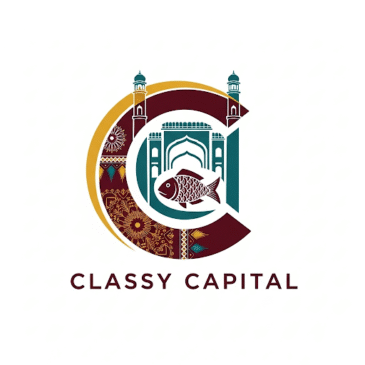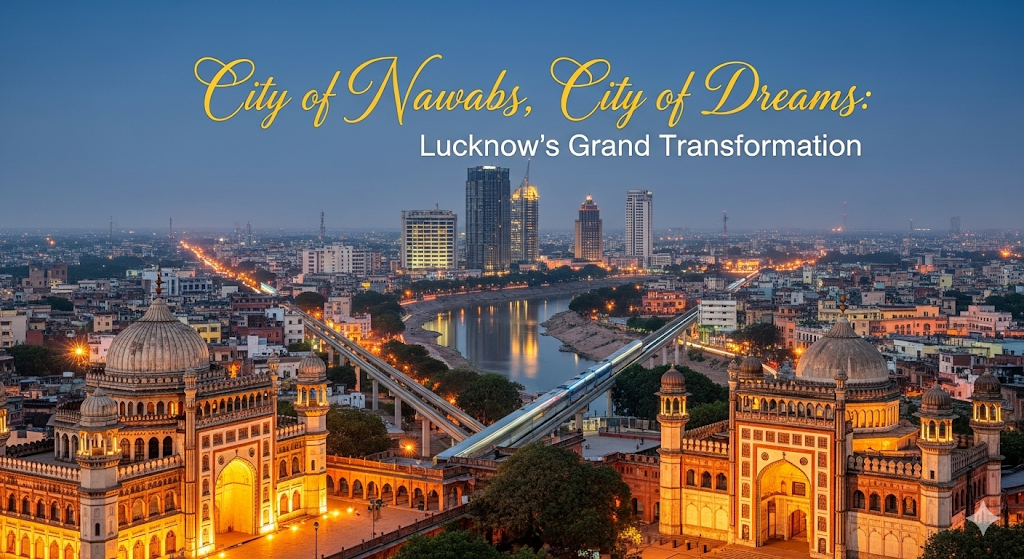 Lucknow: Lucknow, the capital of Uttar Pradesh, is more than just an administrative hub of northern India; it is a living tapestry of history, culture, and modern aspirations. Known worldwide for its refined etiquette—Lucknowi Tehzeeb—its sumptuous cuisine, and its architectural legacy, the city has transformed remarkably over the past two and a half centuries. From a modest riverside town on the banks of the Gomti, it rose to prominence under the Nawabs of Awadh, endured colonial restructuring, adapted to post-independence pressures, and has today emerged as one of India’s fastest-growing cities.
Lucknow: Lucknow, the capital of Uttar Pradesh, is more than just an administrative hub of northern India; it is a living tapestry of history, culture, and modern aspirations. Known worldwide for its refined etiquette—Lucknowi Tehzeeb—its sumptuous cuisine, and its architectural legacy, the city has transformed remarkably over the past two and a half centuries. From a modest riverside town on the banks of the Gomti, it rose to prominence under the Nawabs of Awadh, endured colonial restructuring, adapted to post-independence pressures, and has today emerged as one of India’s fastest-growing cities.
Lucknow’s fascinating evolution is testimony of how Nawabi heritage coexists with its modern metropolitan identity.
The Nawabi Era: The Foundation of a Capital (1775–1856)
Lucknow’s rise began in 1775, when Nawab Asaf-ud-Daula, the fourth Nawab of Awadh, shifted the capital from Faizabad to Lucknow. The decision was more than political—it marked the start of a cultural renaissance that would shape the city’s identity for generations.
Determined to rival Mughal Delhi in grandeur, Asaf-ud-Daula commissioned monumental architectural projects. The most iconic was the Bara Imambara, completed in 1784, built both as a Shia congregation hall and as a famine relief measure. The structure, with its labyrinthine Bhulbhulaiya and massive central hall constructed without iron beams, remains a marvel of Indo-Islamic architecture. Alongside it, the Rumi Darwaza, modeled after Istanbul’s Sublime Porte, served as a ceremonial gateway and a symbol of Lucknow’s cosmopolitan ambition.
Markets such as Chowk and Aminabad flourished under Nawabi patronage, becoming bustling centers of trade in textiles, jewelry, and perfumes. Artisans from across India were invited, leading to the flourishing of chikankari embroidery and zardozi craft, both of which remain integral to Lucknow’s identity today.
Cultural life was equally vibrant. Urdu poetry thrived, with poets such as Mir Taqi Mir and, later, Mirza Ghalib gracing the city. Kathak dance found renewed expression in the Nawabi courts, evolving into the refined style associated with Lucknow today. The Nawabs cultivated a syncretic culture, blending Persian and Mughal influences with local traditions.
The reign of Wajid Ali Shah, the last Nawab, epitomized this cultural efflorescence. A poet, dramatist, and patron of the arts, he built the Qaiserbagh palace complex and promoted theatrical performances such as rahas (dance-dramas). His rule, however, also coincided with rising British influence, and in 1856, the East India Company annexed Awadh, ending the Nawabi era.
The British Era: Restructuring and Colonial Order (1856–1947)
The annexation of Awadh dramatically altered Lucknow’s trajectory. Wajid Ali Shah was exiled to Calcutta, and the city became the stage for one of the fiercest chapters of the 1857 Revolt. The Siege of Lucknow, particularly the defense of the British Residency, etched the city into the history of India’s first war of independence. Large swathes of the city were destroyed, and the aftermath was marked by repression and restructuring.
The British sought to imprint their authority through urban planning. Wide roads such as Hazratganj were constructed for easy troop movement. Hazratganj gradually developed into a commercial and social hub, lined with shops modeled after London arcades, offering imported goods as well as local wares.
Architecturally, colonial and Indo-European styles began to dominate. The construction of La Martiniere College by French adventurer Claude Martin, and later the Husainabad Clock Tower, introduced Western aesthetics to the cityscape. At the same time, remnants of Nawabi grandeur—Imambaras, palaces, and gardens—stood as reminders of a more opulent past.
Railways accelerated Lucknow’s integration into colonial India. The Charbagh Railway Station, inaugurated in 1914, not only served as a vital transportation link but also became an architectural landmark with its blend of Mughal and Rajasthani motifs.
Education flourished with the founding of the University of Lucknow in 1921, which soon became a hub of intellectual and nationalist activity. Urdu literature thrived, with writers and poets capturing both nostalgia for the Nawabi past and the aspirations of a changing India.
By the mid-20th century, Lucknow was firmly entrenched as a colonial administrative center, its syncretic culture surviving amidst new institutions of governance and education.
Post-Independence: Capital of Uttar Pradesh (1947–1990)
When India gained independence in 1947, Lucknow was designated as the capital of Uttar Pradesh, India’s most populous state. This decision elevated its political significance and initiated a fresh phase of urban expansion.
The Vidhan Sabha, or Legislative Assembly, became the city’s most prominent political landmark, symbolizing its new role as a seat of democratic governance. Government offices, administrative quarters, and official residences multiplied, necessitating new layouts and colonies.
New residential areas such as Nirala Nagar, Indira Nagar, and later Gomti Nagar emerged, the latter envisioned as a planned township with wide roads, parks, and modern amenities. These expansions marked the city’s transition from a compact Nawabi-British settlement to a sprawling capital.
Industrialization played a pivotal role. The establishment of Hindustan Aeronautics Limited (HAL) brought aerospace manufacturing to the city, while institutions like the Sanjay Gandhi Postgraduate Institute of Medical Sciences (SGPGI) and the Indian Institute of Management, Lucknow (IIM-L) established in 1984, positioned Lucknow as an educational and medical hub.

Migration from rural Uttar Pradesh and partition-related resettlements swelled the city’s population. This rapid growth strained civic infrastructure, leading to traffic congestion, inadequate housing, and environmental stress, particularly on the Gomti River. Yet, Lucknow retained its cultural ethos. Festivals, cuisine, and its famed Tehzeeb continued to define its social life.
The Contemporary Era: Lucknow as a Modern Metropolis (1990–Present)
Since the 1990s, Lucknow has undergone rapid transformation, propelled by economic liberalization, globalization, and urbanization.
Infrastructure and Connectivity
The inauguration of the Lucknow Metro in 2017 was a milestone in modern public transport. With its expanding corridors, the metro has eased traffic, improved connectivity, and symbolized the city’s shift toward modern urban infrastructure.
Expressways such as the Lucknow-Agra Expressway and the Purvanchal Expressway have made the city a key node in Uttar Pradesh’s infrastructure network. The expansion of the Chaudhary Charan Singh International Airport has boosted international connectivity, supporting tourism and trade.
Gomti Nagar and Beyond
Gomti Nagar, developed as a planned township, has become the epicenter of modern Lucknow. High-rise residential complexes, IT parks, malls like Phoenix Palassio, and entertainment hubs reflect the aspirations of a rising middle class. Shaheed Path, the city’s outer bypass, has encouraged real estate development, drawing corporate offices and institutions.
Economic Diversification
Lucknow’s economy has diversified beyond administration and handicrafts. The IT sector has grown with the establishment of an IT City housing global firms like TCS and HCL. Retail and hospitality have boomed, making Lucknow a regional commercial hub. Traditional industries, particularly chikankari embroidery and zardozi work, have found new global markets, supported by government and private initiatives.
Education and Healthcare
The city has expanded its academic and healthcare footprint with institutions like Dr. Ram Manohar Lohia Institute of Medical Sciences and Babu Banarasi Das University. Lucknow is increasingly viewed as an educational destination, attracting students nationwide.
Culture and Identity
Despite modernization, Lucknow has held on to its cultural essence. Events such as the Lucknow Mahotsav, Kathak performances, and literary festivals celebrate its heritage. Its cuisine—kebabs, biryanis, kulfi—continues to delight both locals and visitors. The city remains a custodian of Urdu poetry, storytelling traditions, and the celebrated etiquette of hospitality.
Challenges of Urban Growth
With expansion, Lucknow faces significant challenges. Unchecked construction and encroachment have reduced green spaces. Air pollution and waste management are pressing concerns. The Gomti River, once the city’s lifeline, suffers from industrial effluents and untreated sewage, despite riverfront beautification efforts.
Heritage conservation is another challenge. Many historical structures require restoration, and balancing urban development with heritage preservation remains a delicate task.
Traffic congestion, inadequate public transport in peripheral areas, and rising land prices also strain the city’s livability. Yet, initiatives under the Smart Cities Mission aim to improve sustainability, governance, and infrastructure.
Lucknow Today: A Blend of Past and Future
As of 2025, Lucknow has a population of over 3.5 million and is one of India’s fastest-growing urban centers. It symbolizes a rare balance—holding on to its Nawabi past while embracing modern aspirations.
The Bara Imambara and the Residency ruins coexist with glass-fronted malls and IT towers. The old bazaars of Chowk still sell traditional handicrafts, while metro trains glide overhead. In its people, cuisine, and culture, the essence of Tehzeeb endures, reminding the world that progress and tradition can flourish together.
Lucknow’s journey from a Nawabi capital to a modern metropolis is a story of resilience, adaptation, and continuity. Each phase of its growth—Nawabi opulence, colonial restructuring, post-independence expansion, and contemporary urbanization—has left an indelible imprint on the city’s character.
Today, Lucknow is not just the political heart of Uttar Pradesh but also a thriving center of education, culture, technology, and commerce. Its ability to preserve its heritage while embracing modernity makes it unique among Indian cities.
From the arches of the Rumi Darwaza to the sleek carriages of the Lucknow Metro, the city embodies a timeless duality—where history whispers in every corner even as the future beckons with opportunity.






